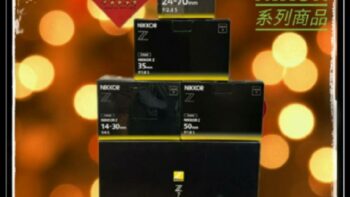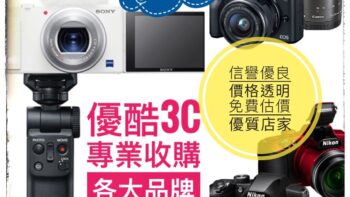高價 canon鏡頭收購 請立即與我們聯絡 收購canonRF系列,RF定焦,RF廣角,RF旅遊,收購EF-M系列,收購大三元,小三元,收購L鏡,收購Marco,二手鏡頭,全新鏡頭,鏡頭買賣,鏡頭收購 Read More ...

收購相機及鏡頭 您用不到相機鏡頭 不論新舊,都可以換現金 陪您走過每個黃金歲月的年頭,現在因為家庭或工作總總因素,這些可愛的相機及鏡頭寶貝們,除了躺在倉庫,安靜在防潮箱等候主人帶它們出勤之外,應該可以有個兩全其美的辦法"就是讓給有緣人",讓它再度發揮存在地球上的價值吧!

高價 canon鏡頭收購 請立即與我們聯絡 收購canonRF系列,RF定焦,RF廣角,RF旅遊,收購EF-M系列,收購大三元,小三元,收購L鏡,收購Marco,二手鏡頭,全新鏡頭,鏡頭買賣,鏡頭收購 Read More ...

線上估價 我們是專業的3C收購,高價收購您不用的3C產品,價格好不怕您比較!! 我們專業經營各項3C高價回收,清運協助,可開立單據,多通路多管道,非坊間垃圾回收價,價格不怕您比較,歡迎企業戶汰舊換新, Read More ...

線上估價 鏡頭收購 canon 鏡頭收購,二手鏡頭收購,全新鏡頭收購,收購nikon鏡頭,收購sony鏡頭,收購leica鏡頭,收購fujifilm鏡頭,收購panasonic鏡頭,收購zeiss鏡頭 Read More ...

高價 nikon鏡頭收購 請立即與我們聯絡 收購nikone鏡頭,收購nikon z,收購nikon z 40mm,z 50mm,z 35mm,z 20mm,z 24mm,z 28mm,收購af-s Read More ...

SONY鏡頭收購 全新SONY鏡頭收購 E-Mount鏡頭,FE 24-70MM,VCL-ECU2,FE 24-105MM,E PZ 18-105MM,FE 16-35MM,FE 35MM FE 70 Read More ...

PENTAX 鏡頭收購 標準定焦 (35-50) 廣角定焦 (21-31) 望遠定焦 (118-200) 中望遠定焦 (55-100) 超望遠定焦 (236-560) 廣角變焦 (20-82.5) 超 Read More ...
估價鏡頭收購orresponding part of a standard desktop keyboard.
Jim Salter
From the left: 40-pin GPIO header, microSD card slot, two micro-HDMI output ports, a USB-C power port, two USB 3.0 type-A ports and one USB 2.0 type-A port, Gigabit Ethernet port, Kensington lock slot.
Jim Salter
From the left: 40-pin GPIO header, microSD card slot, two micro-HDMI output ports, a USB-C power port, two USB 3.0 type-A ports and one USB 2.0 type-A port, Gigabit Ethernet port, Kensington lock slot.
Jim Salter
The visible hump on the underside of the Pi4 provides a comfortable typing angle and clearance for the passive-cooling vents.
Jim Salter
The visible hump on the underside of the Pi4 provides a comfortable typing angle and clearance for the passive-cooling vents.
Jim Salter
From the left: 40-pin GPIO header, microSD card slot, two micro-HDMI output ports, a USB-C power port, two USB 3.0 type-A ports and one USB 2.0 type-A port, Gigabit Ethernet port, Kensington lock slot.
Jim Salter
The visible hump on the underside of the Pi4 provides a comfortable typing angle and clearance for the passive-cooling vents.
Jim Salter
Unboxed and plugged in, the Pi 400 is functional but not particularly lovely. On the plus side, the integrated keyboard means fewer cables to deal with. Unfortunately, the remaining cables are unusually likely to snarl and look a bit feral. They are both stiffer and shorter than I’d prefer in an ideal world, making it difficult to impossible to end up with a setup that doesn’t look like a rat’s nest. The red cable for the mouse clashes pretty violently with the off-white cables for USB-C power and micro-HDMI out, which doesn’t help any.
That said, it’s important to remember that the entire kit retails for $100. Within the limits of the Pi 400’s very generous price, it’s not really fair to complain too hard about a few aesthetic gaffes here and there! Consumers with a few extra dollars to spend might want to consider replacing the Pi 400’s mouse with something a bit more functional, though… and a full-sized keyboard might not be a bad idea while you’re at it.
The integrated keyboard is functional but noticeably narrower than a standard keyboard. I’m not generally sensitive to variations in keyboard layout due to a long career involving Other People’s Computers in large numbers, but I was plagued with constant mistyping problems the entire time I tested the Pi 400.
It’s also worth noting that, while the Pi 400 supports dual displays, it does so with micro-HDMI ports, not full-sized ones—and it ships with a single cable. You’ll need an extra cable if you want to use your Pi 400 with dual displays—and since it ships with a micro-HDMI to HDMI cable, not an adapter, things will get complicated if you want to use it with, e.g., portable LED displays that have off-sized ports themselves.
Finally, there’s no 3.5mm audio jack on the Pi—if you’ve got it hooked to a television or a monitor with speakers, it can deliver audio over HDMI; otherwise you’ll need a supported USB audio device. I tested with an inexpensive USB gaming headset, which worked fine.
Impressions—Raspberry Pi OS
Raspberry Pi OS suspects you might be using it on a television, not a proper monitor—so it starts out with significant overscan boundaries by default.
Jim Salter
Raspberry Pi OS suspects you might be using it on a television, not a proper monitor—so it starts out with significant overscan boundaries by default.
Jim Salter
The overscan goes away after a reboot, if you tell the setup dialog, “Yes, I see big black borders.”
Jim Salter
The overscan goes away after a reboot, if you tell the setup dialog, “Yes, I see big black borders.”
Jim Salter
Raspberry Pi OS suspects you might be using it on a television, not a proper monitor—so it starts out with significant overscan boundaries by default.
Jim Salter
The overscan goes away after a reboot, if you tell the setup dialog, “Yes, I see big black borders.”
Jim Salter
We tried playing a 4K 60fps YouTube video on the Pi 400. Even at 1080p, not 4k, it dropped a lot of frames.
Jim Salter
We tried playing a 4K 60fps YouTube video on the Pi 400. Even at 1080p, not 4k, it dropped a lot of frames.
Jim Salter
Checking CPU utilization, we see that the system’s pretty much pegged while trying to play this 60fps video, even at 720p.
Jim Salter
Checking CPU utilization, we see that the system’s pretty much pegged while trying to play this 60fps video, even at 720p.
Jim Salter
We tried playing a 4K 60fps YouTube video on the Pi 400. Even at 1080p, not 4k, it dropped a lot of frames.
Jim Salter
Checking CPU utilization, we see that the system’s pretty much pegged while trying to play this 60fps video, even at 720p.
Jim Salter
I began testing the Pi 400 using its native Raspberry Pi OS Linux distribution—which is basically Debian with LXDE and a lot of middleware optimizing it for the Pi. Unfortunately, there’s almost nothing in the way of standard benchmarking utilities that run on ARM Linux—all I could find was the Phoronix Test Suite, which would have required more time to run than I had to test the device in total. So for the most part, I’m going to talk about my subjective experience, rather than hard numbers.
The good news about the Pi 400 is that it does make a credible desktop PC, in the sense that, yes, you can totally use it without things breaking. With that said, you’re unlikely to forget that you’re using a very inexpensive ARM device. Much like the Pinebook Pro, the Pi 400 exhibits heavy latency while opening applications that’s perhaps possible to live with but impossible not to notice.
Also like the Pinebook Pro, once the applications are actually open, they generally run smoothly enough—although we did find the Pinebook Pro’s hex-core 2.0GHz big/1.5GHz little CPU noticeably punchier than the Pi 400’s straight 1.8GHz quad-core. The biggest problem I had was with high-resolution, high-frames-per-second YouTube videos.
I only tested the Pi 400 with a 1080p monitor, so I can’t speak to its chops with 4K videos—but it’s absolutely not capable of handling the Costa Rica in 4K 60fps HDR video without visible frame drop, even at 720p. The major issue here appears to be the 60fps rate, not the 720p resolution. I also tested the “Forests” episode of Netflix’s docu-series Our Planet on YouTube at 1080p, and that video played back flawlessly.
Examining CPU utilization during playback of the 60fps Costa Rica video, we can see the little 1.8GHz Broadcom quad-core CPU struggling—it’s at its limits, with CPU utilization for all cores at more than 90 percent. Although the BCM2711 supports hardware offload of video decoding—without which, this video would be playing in seconds per frame, rather than just dropping frames a bit—the hardware offload can only do so much, and the CPU is being asked to take on more than it can handle in software.
This effect is even more visible when entering or leaving full-screen playback. On a standard desktop PC, that operation takes perhaps 100-150ms. On the Pi 400, it frequently takes as much as three or four full seconds, during which the video itself tends to keep playing, but the surrounding controls and framework only partially render/stop rendering while the shift finishes taking place.
Getting audio out of the Pi 400 was a bit of a challenge; it defaulted to attempting to deliver audio over HDMI, and Raspberry Pi OS’ audio control dialog isn’t the best. Even after changing the output device to USB Audio (my gaming headset), YouTube wasn’t producing audio—and there’s no “test” button I could find in Pi OS, like the one in Ubuntu’s audio-control dialog. Closing and reopening the browser entirely after changing the output device resolved the issue, and audio played from the headset fine afterward.
All of these quibbles aside, I again have to make note of the sheer inexpensiveness of the Pi 400—it’s only $70 for the device itself or $100 for a kit that includes a mouse, SD card, micro-HDMI to HDMI cable, USB-C power supply, and 247-page full-color guide packed chock-full of tips and projects.
At $100 or less for a functional, reliable, well-packaged, and integrated desktop computing device, I’m not going to get mad about YouTube looking funny and hanging for a few seconds when it shifts back and forth from full-screen. Yes, Walmart’s $350 Gateway laptop is considerably more powerful, and it includes a screen, battery, and much better keyboard… but that $350 would buy five Raspberry Pi 400s.
Ubuntu 20.10 “Groovy Gorilla”
The Pi Foundation shipped us a ready-to-go Ubuntu 20.10 SD card, as well as the Raspberry Pi OS SD card already installed in the system.
Jim Salter
The Pi Foundation shipped us a ready-to-go Ubuntu 20.10 SD card, as well as the Raspberry Pi OS SD card already installed in the system.
Jim Salter
The 60fps Costa Rica video was hilariously unplayable under Ubuntu, but this 30fps YouTube video played back pretty well at 1080p.
Jim Salter
The 60fps Costa Rica video was hilariously unplayable under Ubuntu, but this 30fps YouTube video played back pretty well at 1080p.
Jim Salter
Although the YouTube video for Netflix’s Our Planet episode “Forests” didn’t appear to drop any frames when played back, there was minor screen tearing visible in some scenes.
Jim Salter
Although the YouTube video for Netflix’s Our Planet episode “Forests” didn’t appear to drop any frames when played back, there was minor screen tearing visible in some scenes.
Jim Salter
The 60fps Costa Rica video was hilariously unplayable under Ubuntu, but this 30fps YouTube video played back pretty well at 1080p.
Jim Salter
Although the YouTube video for Netflix’s Our Planet episode “Forests” didn’t appear to drop any frames when played back, there was minor screen tearing visible in some scenes.
Jim Salter
I also tested the Pi 400 under Ubuntu 20.10, which was preflashed on a second SD card that the Pi Foundation shipped specially to us along with the Pi 400 kit. The Ubuntu image is actually an installer itself, not a fully installed OS; on first boot, it walks the user through a few basic questions prior to running the actual installation process, which also goes to the SD card.
In general, Ubuntu 20.10 is exactly as Desktop Engineering Director Martin Wimpress promised me—a fully functional distribution ready-to-go with the Pi 400, without any quibbles about things that don’t work here or there. If you’re familiar with Ubuntu Desktop, you’ll be familiar with Ubuntu on the Pi 400—it just works, and it looks exactly the same as it would on a traditional x86 system.
With that said, it is significantly slower than Raspberry Pi OS, and for the moment, I wouldn’t particularly recommend it on the Pi 400 yet. It’s noticeably slower to boot, slower to open applications, and the 60fps YouTube video that dropped frames here and there under Raspberry Pi OS only renders a frame here or there under Ubuntu.
We suspect that most of the people who are habituated to Ubuntu’s Gnome3-based desktop will find it easier to adapt to Raspberry Pi OS’ functional LXDE-based desktop than to deal with the lower performance that Groovy Gorilla offers right now.
I suspect this will change in the future, as 估價鏡頭收購canonical and the Pi Foundation continue working hand in hand to improve Ubuntu’s integration on the Pi—but Raspberry Pi OS, like Ubuntu, is for the most part just Debian under the hood. I think it’s probably better, for now, for Ubuntu users to adapt to using Pi OS rather than adapting to Ubuntu’s lower performance on the Pi.
Performance and reliability analysis
The Pi 400 doesn’t seem likely to share the Pi 4’s overheating problems—I never saw CPU temp higher than 52°C.
Jim Salter
The Pi 400 doesn’t seem likely to share the Pi 4’s overheating problems—I never saw CPU temp higher than 52°C.
Jim Salter
Although YouTube enjoys hardware video decoding offload on the Pi 400, there’s still a lot going on in software, as this Netdata graph while watching Our Planet—Forests in 1080p demonstrates.
Jim Salter
Although YouTube enjoys hardware video decoding offload on the Pi 400, there’s still a lot going on in software, as this Netdata graph while watching Our Planet—Forests in 1080p demonstrates.
Jim Salter
The Pi 400 doesn’t seem likely to share the Pi 4’s overheating problems—I never saw CPU temp higher than 52°C.
Jim Salter
Although YouTube enjoys hardware video decoding offload on the Pi 400, there’s still a lot going on in software, as this Netdata graph while watching Our Planet—Forests in 1080p demonstrates.
Jim Salter
It’s not hard to spot the time at which I shifted the Costa Rica video from 480p/30fps to 720p/60fps.
Jim Salter
It’s not hard to spot the time at which I shifted the Costa Rica video from 480p/30fps to 720p/60fps.
Jim Salter
Netdata itself consumes a significant amount of the Pi400’s CPU—especially while the real-time graphing interface is visible.
Jim Salter
Netdata itself consumes a significant amount of the Pi400’s CPU—especially while the real-time graphing interface is visible.
Jim Salter
It’s not hard to spot the time at which I shifted the Costa Rica video from 480p/30fps to 720p/60fps.
Jim Salter
Netdata itself consumes a significant amount of the Pi400’s CPU—especially while the real-time graphing interface is visible.
Jim Salter
The best news about the Pi 400’s performance and reliability is that the device doesn’t seem to share the Pi 4’s predilection for overheating. Despite having no active cooling, the Pi 400 never got within 30°C of its thermal limits in my testing—even during a 10-minute-long CPU stress test, using stress-ng. My office was at 28°C during testing; the Pi 400 idled at about 32°C and peaked at 52°C—and it’s rated for unthrottled operation up to 85°C.
Moving on from the thermals, I wanted to get a little more detail about what’s happening when the Pi 400 opens applications sluggishly and plays back video less than smoothly. A lot of readers got excited about Ubuntu’s new firmware, which allows USB booting, potentially overcoming SD card I/O limitations—so I particularly wanted to look for spikes in CPU iowait (time the processor spends waiting for data to come back from storage).
Although there is an occasional large spike in iowait (magenta areas on the graph)—like the one visible on CPU3 at about 16:52:40—they’re uncommon. For the most part, what I’m seeing here is just plain not enough CPU to get transient, high-demand tasks done as quickly as x86 users are accustomed to getting them done. Opening applications is hard work—significantly harder, in many cases, than actually running those applications—and the lack of grunt in the BCM2711 is readily apparent there.
We can also see that lack of CPU firepower readily in the Netdata graphs when shifting the Costa Rica video from 480p/30fps to 720p/60fps. At 480p/30fps, the CPU spends most of its time beneath 50-percent CPU utilization, with frequent but narrow spikes up to 80 percent or higher. But when we try to render 60fps video, the CPU spends almost all of its time at 80 percent or higher, on all four cores—making it effectively saturated, with the result of rendering video in seconds-per-frame rather than the other way around.
It certainly can’t hurt to replace the onboard SD card with a high-performance USB3 solid-state drive—but I don’t believe it will really solve the underlying issue that the Pi 400 is still a Pi, with a passively cooled CPU that just doesn’t stack up to actively cooled x86 CPUs in standard desktops and laptops.
Disassembly
There are no screws on the outside of the Pi 400’s chassis—so don’t bother prying up the rubber feet on the bottom. Insert a plastic spudger and gently pry clips loose all the way around the chassis.
Jim Salter
There are no screws on the outside of the Pi 400’s chassis—so don’t bother prying up the rubber feet on the bottom. Insert a plastic spudger and gently pry clips loose all the way around the chassis.
Jim Salter
With the chassis opened, the keyboard can be flipped over, revealing a heat spreader covering most of the Pi 400’s board.
Jim Salter
With the chassis opened, the keyboard can be flipped over, revealing a heat spreader covering most of the Pi 400’s board.
Jim Salter
The chassis didn’t have screws, but the heat spreader does. They look funky, but a Phillips-head driver fits them.
Jim Salter
The chassis didn’t have screws, but the heat spreader does. They look funky, but a Phillips-head driver fits them.
Jim Salter
With the chassis opened, the keyboard can be flipped over, revealing a heat spreader covering most of the Pi 400’s board.
Jim Salter
The chassis didn’t have screws, but the heat spreader does. They look funky, but a Phillips-head driver fits them.
Jim Salter
You’ll also need to disconnect the keyboard’s ribbon cable. Flip up the black plastic ledge, and the cable slides out—there is no pinned-out connector; the clip pins the cable’s conductors down to their mates.
Jim Salter
With the keyboard cable detached, we can gently pry up the heat spreader—but be careful; it’s attached to the CPU with double-sided thermal tape.
Jim Salter
It’s amazing how clean and simple a typical ARM board really is. The BCM2711 CPU is centered on the board, under and slightly right of the HDMI logo.
Jim Salter
There’s not a whole lot of reason to crack open the Pi 400, apart from sheer curiosity—what little is on the board at all is soldered down, and with the entire device only costing $70, we’re not sure there will ever be much market for replacing the motherboard in an existing chassis.
If you decide to break open a Pi 400 anyway, you’ll need a spudger—the chassis isn’t held together with any screws at all, so don’t bother peeling the feet off the underside. Instead, take a fine-edged spudger and gently work it into the seam—eventually, you’ll expose one of many little rectangular cutouts that allow further prying. At each one, gently work the spudger a little bit deeper, then just continue to slide it across the device inside the seam.
The clips on the chassis are tight, so we really do not recommend substituting a knife blade for a proper spudger here—if you do, you’l

▲台灣資安廠商匯智安全科技參加日本CEATEC展,推出全球首支整合檔案加密功能的無密碼認證金鑰SAMURAI Key(武士之鑰)。(圖/匯智提供)
記者蘇位榮/台北報導
隨著科技的快速進展,駭客技術不斷革新,其中密碼破解已成為資料侵入的首選策略。研究指出,大約有80%的資料外洩皆與密碼安全有關。一旦密碼被破解,不論個人或企業,資訊安全都會面臨巨大威脅。
台灣資安廠商匯智安全科技日前參加日本CEATEC消費電子展,推出全球首支整合檔案加密功能的無密碼認證金鑰SAMURAI Key(武士之鑰),不僅提供無密碼認證,更加強了資料加密保護,有效降低資料外洩的風險。
密碼外洩不僅可能導致隱私資料遭竊,更可能使企業遭受財務損失及品牌受損,甚至面臨法律訴訟。因此,加強資訊安全和密碼保護已成為當前急需解決的問題。
零信任(Zero Trust)因應而生,是一種資訊安全架構原則,核心理念是「永不信任,始終驗證」。它假設內部和外部的網路都是不可信的,並要求在授予任何訪問權限之前,對所有使用者和系統進行嚴格的身份驗證和授權。
Google積極推出Passkey無密碼登入技術就是基於零信任(Zero Trust)原則,Passkey技術會要求一些關於使用者的真實信息,例如指紋、面部辨識,以確保只有經過驗證的使用者可以訪問其帳戶或敏感信息,這種技術允許使用者僅透過生物特徵或個人設備解鎖來登入他們的帳戶,而無需輸入傳統的密碼。
根據Microsoft的研究數據,解決密碼問題能減少高達99.9%的身份驗證風險。面對此挑戰,SAMURAI Key不僅提供了解決方案,並加入了加密隨身碟和端點檔案加密功能,進一步保護了企業和個人資料。
匯智安全科技總經理鄭嘉信表示,Passkey技術與SAMURAI Key同樣基於FIDO2與Webauthn標準。隨著Passkey的興起,預期將有更多服務開始支援安全金鑰登入。
CEATEC是日本最大消費電子展,於10月17日至10月20日在千葉幕張舉行。匯智安全科技以「強化企業端點安全(Endpoint Security)」為主題,提出電腦遭非法登入與資料外洩的解決方案。企業客戶可以透過伺服器嚴謹控管SAMURAIKey,消除過往日本企業對遺失隨身碟會導致資料外洩的顧慮。日本電波株式會社、估價鏡頭收購canon、KDDI、OMRON、南星海運等都蒞臨攤位觀看動態展示。
匯智安全科技行銷企劃林蓉萱表示:「對於追求更高安全,要求或希望使用非手機登入方法的用戶,SAMURAI Key不僅滿足了他們的基本需求,而且超越了他們的期望,提供了加密保護資料的功能。」
除了參展外,「SAMURAI Key(武士之鑰)」也在日本群眾募資平台推出,12小時就成功達成募資金額,大受好評原因是Samurai key 滿足高端商務人士三個資安需要:一是取代密碼難記與洩漏;二是沒有遺失隨身碟造成資料洩漏的擔憂;三是加密筆電桌機檔案,確保隱私。受到日本人肯定與支持,也為台灣在全球資安的領域攻占一席之地。
鄭嘉信表示,設計Samurai Key之初,匯智安全科技同時將企業管理的資安需要考慮在內,把透過企業伺服器控管功能放入,扭轉了企業對 USB 隨身碟使用將導致資料外洩的擔憂。為進一步服務企業客戶,匯智安全科技可按照企業安全政策與需求進行 OEM 及 ODM 客製。透過整合「加密隨身碟」與「無密碼認證」,提供個人與企業更完整且全面的資安防護。
鄭嘉信補充說明:「不管是零信任,或是FIDO2,無密碼認證金鑰,對於一般使用者來說,都只是新穎的名詞,但卻是迫在眉睫必須解決的事。」匯智安全科技透過創新的技術和解決方案,正為全球資安市場樹立新的標準,並推動資訊安全向前發展。
估價鏡頭收購 估價鏡頭收購